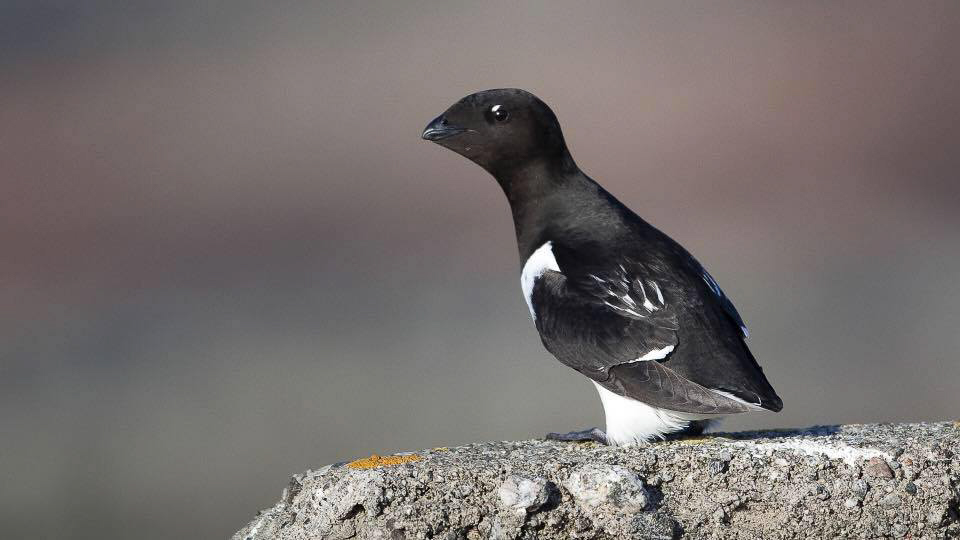
Photo © NTNU
The little auk or dovekie (Alle alle) is a small auk, the only member of the genus Alle. Alle is the Sami name of the long-tailed duck; it is onomatopoeic and imitates the call of the drake duck. Linnaeus was not particularly familiar with the winter plumages of either the auk or the duck, and appears to have confused the two species. Other common names include rotch, rotche, bullbird, and sea dove, although the latter sometimes refers to a relative of dovekies, the black guillemot.
Dovekies breed on islands in the high Arctic. There are two subspecies: A. a. alle breeds in Greenland, Novaya Zemlya and Svalbard, and A. a. polaris on Franz Josef Land. A small number of individuals breed on Little Diomede Island in the Bering Strait with additional breeding individuals thought to occur on King Island, St. Lawrence Island, St. Matthew Island and the Pribilof Islands in the Bering Sea.
This is the only Atlantic alcid of its size, half the size of the Atlantic puffin, at 19–21 cm (7.5–8.3 in) in length, with a 34–38 cm (13–15 in) wingspan. An adult dovekie's weight ranges from 130 to 200+ g (4.7 to 7.2+ oz). A. a. polaris is generally larger than the nominate subspecies. In breeding plumage, dovekies are black on the head, neck, back, and wings, with white underparts. The bill is short and stubby. They have a small rounded black tail. The lower face and fore neck become white in winter plumage.
Flight is fast and direct, with rapid whirring wing beats due to dovekies' short wings. These birds forage for food like other auks by swimming underwater. They mainly eat crustaceans, especially copepods, of which a 150 g (5.3 oz) bird requires ~60,000 individuals per day (equivalent to 30 g [1.1 oz] of dry food weight), but they also eat small invertebrates such as mollusks, as well as small fish. Recent evidence suggests that the little auk forages not by filter-feeding on planktonic prey, but by visually-guided suction-feeding. They feed close to the shoreline during the breeding season, and feed near coastlines and ice edges during the winter.
Little auks produce a variety of twitters and cackling calls at the breeding colonies, but tend to be silent at sea.
Little auks breed in large colonies on marine cliffsides. They nest in crevices or beneath large rocks, and may build rudimentary nests by bringing small pebbles and/or old grasses and lichen into the cavity, where they lay a single egg.Their single pale greenish blue egg is placed in a crevice of the rocks. Dovekies, like other alcids, are monogamous and have high nest-site fidelity, meaning that they often reusing the same cavity as a nest site by the same pair, year to year. Eggs are generally incubated by both parents equally, for roughly a month (28-31 days), until chicks begin to pip at about 25 days. Hatchlings generally weigh a mere 21 g and are unable to thermoregulate on their own. The hatchlings are brooded for approximately 5 days until they are able to thermoregulate, after which they are only attended to for feeding by parents. Young dovekies fledge from their nests at an age of 26-29 days old, synchronously with conspecifics on the colony, usually at night. All dovekies migrate south by winter into northern areas of the North Atlantic. The species is also commonly found in the Norwegian Sea. Late autumn storms may carry them south of their normal wintering areas, or into the North Sea, and can cause wrecking of these birds, along with other seabirds, on-land.
The glaucous gull and the Arctic fox are the main predators of little auks at colonies, with other gulls and raptors predating the species as well. In some cases, the polar bear has also been reported to feed on little auk eggs.
Although populations appear to be decreasing, this is not currently thought to be rapid enough to be of concern for the species in the medium term, especially as global little auk numbers are generally rather fluid. Little auks have been shown to be able to buffer fluctuations in prey availability, caused by climate change, via plasticity in their foraging behavior, which is likely to make accurate conservation assessments more difficult.
Due to the nature of dovekies to feed near shore during both summer and winter months, the species has been an important source of food for Inuit of Greenland, Baffin Island, and Labrador, as well as at parts of its southern range in eastern Canada.
Kiviaq is an Inuit dish from Greenland. It is made by stuffing a seal skin with 300 to 500 little auks. Once full and airtight, the skin is sealed with seal fat and the little auks are left to ferment for 3 to 18 months under a pile of rocks. Caught in spring, little auks are a human food resource in winter.
Knud Rasmussen's death is attributed to food poisoning by kiviaq.
On the south coast of Newfoundland, Canada the dovekie is known colloquially as the Bull(y) Bird or Ice Bird. The birds were once hunted, stuffed with savoury dressing and oven-baked. It was a food of last resort to prevent winter starvation amongst the fisher people of Newfoundland's outport communities. Shot with BB pellets on ice pans off Newfoundland's south coast, a feed would consist of 5–6 birds per person. Similarly, a hunt still exists today for murres in the province of Newfoundland and Labrador, and mainly acts as a subsistence hunt for traditional hunters, who shoot wintering murres near ice flows in coastal waters as a food source.
Source: Wikipedia